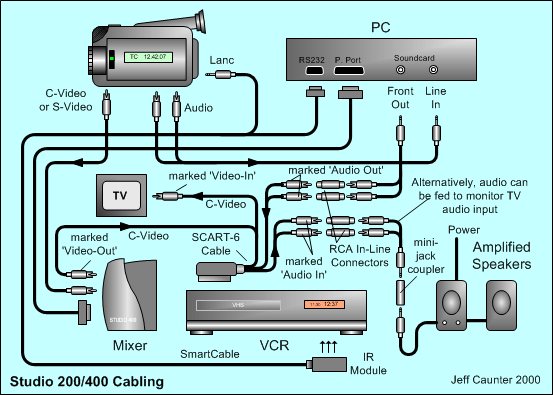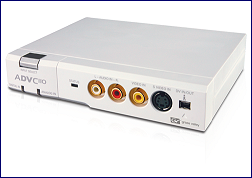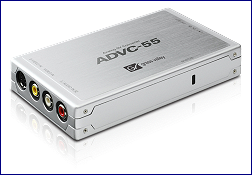



I was waiting for an affordable solution to be available for the PC. This came in 1996 when Gold Disk Inc. Introduced the Video Director system. In 1997 Pinnacle Systems purchased Gold Disk and, one year later, released an improved version which they called Studio200, which was my first introduction to video editing using the PC.
In effect it was a glorified edit controller, with facilities for adding titles, transitions, and effects by means of an external unit called a mixer which was controlled from the PC’s parallel port. The camcorder and VCR were controlled from a serial RS232 port -
When it was time to make the movie the PC shuttled the camcorder back and forth, pausing and starting the VCR at the appropriate times, according to the EDL, to gradually assemble the movie. When a transition, title, effect, or still image was encountered, then the mixer came into play to add these to the video stream, having been primed with these from the PC’s parallel port. All-
In 1998 Pinnacle released a new version -
These two Studio versions marked such a milestone in home movie editing, that I felt compelled to describe them in basic detail above, and include a diagram below of how the various components were hooked up together for the sake of completeness. Compare this with the simplicity of the systems we use today.

When digital-
The program could be operated in one of two modes -
The editing process was similar to the earlier Studio400, producing an EDL as before. The Make Movie process was different however, and varied according to whether Preview Capture was used or not. In either case, the external hardware mixer was no longer required, as everything was mixed and rendered in software and no longer needed to be performed in real-
If Preview Capture had been used, then the program first searched the camcorder for scenes detailed in the EDL, and captured them to the computer as individual files in full resolution (each of which were unlikely to exceed the 4GB limit). Any transitions, titles, or effects that had been applied were then rendered into separate sections and added to the hard disk. When it became time to output the movie to tape (using the camcorders Video-
If the Full Capture mode was used, then only the transition/title/effect rendering process was performed to create auxiliary files on the disk. When outputting to tape or file, the EDL was used to select the correct frames from the captured video, and then output sequentially, with the auxiliary files inserted at the appropriate times. One of the advantages of the Full Capture mode was that the camcorder’s timecode no longer needed to be continuous, Studio created its own timecode during capture. The down-
There have been many new versions of Studio released since the early days, each bringing with it something new. First came the inclusion of HollywoodFX, a collection of 3D transitions and effects. DVD authoring was later introduced, which also included the production of VideoCD and SVCD discs. A Plug-
Ever since the early days of Studio, an increasing number of competing video editing applications have been introduced by different manufacturers. Even Pinnacle themselves released Edition/Liquid, which was a result of their acquisition of the Fast Corporation. This was more of a prosumer application, was more expensive, and less easy to use, and was not really a threat to Studio. Even though these products may be quite capable in their own right, I have always remained loyal to the Studio line, as it is easy to use (and to come back to), is affordable, has always worked for me, and produces professional-
In 2005 Pinnacle Systems was purchased by the Avid Corporation, as a means of adding an entry-
I devote a separate page to PS16 under the heading of ‘My Favourite Software’. You will find it HERE.


Another solution to performing analogue conversion is to use a DV camcorder, providing it has a VCR Mode, separate analogue connections, and supports ‘pass-
Versions of Pinnacle Studio up to 15 supported export to Firewire devices, but in AS1 and S16, this has been dropped for some reason -
In the beginning there was film. There was little opportunity to edit this, other than cut and splice it. Adding titles, transitions and effects had all to be done previously in the camera -
When video arrived, things didn’t get easier overnight. Gone was the chance to physically make cuts and splices, but copying was now possible to a VCR, and selective copying of scenes in any order could now be done which was nearly as good -
In parallel with Studio, Pinnacle also marketed the DC10 system which it purchased from the German company Miro. The editing software was provided by Premiere, under license from Adobe, which made it expensive, and not really suitable for home use. There was also the short-
Although the majority of editing today is done with digital video, there is still a need to be able to capture legacy analogue footage (Betamax, VHS, 8mm, Hi8, etc). There have been several devices released on the market to enable this, and there have been earlier versions of Studio that included suitable hardware. A common problem with many of these, however, has been the loss of synchronisation between audio and video on long captures. A solution to this came with the production of the ADVC range of converters by Canopus (now Grass Valley), which included special circuitry to guarantee synchronisation. These interface with the Firewire port on the computer, and appear to the editing software as a DV camcorder. The latest versions of these are the ADVC55, which handles only analogue input, and the ADVC110 which handles both analogue input and output. I have used an earlier model, ADVC100 for several years, and it has behaved flawlessly.
Most editing software allows for the insertion of still images. It is therefore possible to create very attractive slide-
Another use for an editor with multiple A/V timeline tracks is to use it to mix sound files together, either in-
No discussion on movie editors would be complete without mentioning this as a budget-
All-
The down side is that it recognises only a fairly limited number of file types, does not support HD, and does not include facilities for authoring DVDs. The latter can be overcome by outputting to disk in DV-
- Go easy on fancy transitions and effects -
it is very easy to make the movie look ‘cheesy’ and tiresome to watch. Stick to straight cuts, dissolves, and the odd fade- through- black for the body of your movie. Occasional use of wipes can be useful, but reserve the bewildering arrays of complex transitions and effects for creating engaging titles and, of course, slide- shows (but again, don’t overdo it).
- Do not add music or narration too early in the editing process. It is better to lay down and edit the visuall aspect of the movie first, and get that right, before adding extra sound.
- Be drastic with your cutting -
without destroying the interest of the ‘story’. Be prepared also to leave out the odd scene if it doesn’t fit in. Try to keep the pace of the story going at a reasonable rate.
- Be aware of the camera soundtrack -
try to make cuts at a convenient point in the sound.
- Keep clips short -
around 5- 10 seconds is a good rule. If you have a long clip, that cannot easily be cropped, then consider inserting a cut- away shot somewhere near the middle. Either use this cut- away in its entirety, or just insert the video part, leaving the sound from the original clip intact. This insertion is known in editing circles as using ‘B- Roll’. When there is a lot of action however, longer scenes are acceptable.
- Learn about J-
Cuts and L- Cuts - this is where the audio precedes the next clip, or hangs over from the previous clip. This can be useful occasionally to smooth over a cut between two very different scenes without using a visual transition.
- Make use of titles occasionally if needed throughout your movie to announce a change of location, a new day, or to alert your audience to something interesting about to happen. Use in-
line or overlay titles, whichever seems appropriate. (If your movie is narrated, or uses actor lines from a script, then inserted titles may not be necessary).
- Do not make title text too ‘fussy’ -
use reasonably large, clear, fonts and brief text.
- Title durations -
make them last as long as it takes to read the text twice.
- Do not make the movie too long. As a rule, aim for about 30-
40 minutes. If this is not possible, consider making it in more than one part. If you are outputting to DVD, then these parts could become ‘chapters’ in the menu, to be viewed at more than one sitting, or after an Intermission - cup of tea? (If you get a reputation within the family for producing movies of epic durations, you will find that they will cease to be keen to watch your latest creations)
- A lot can be learned from watching and analysing how films and TV programs have been edited. Although you probably don’t have the luxury of multiple camera footage, the general principles are all there to be taken onboard.
- After your final editing session, leave it alone for a couple of days, then watch it in its entirety. You will soon see if there are any obvious problems, or adjustments that should be made. This will generally only be needed to be done once.
- If you are making a DVD, export this to hard disk as an image first, then burn your DVD from this image. Directly burning DVDs from your editor can easily result in a failed burn. Also, being able to play your image in a software player like PowerDVD or WinDVD will give you the opportunity to check out your menu navigation design before you burn any discs.
Editing movies can be absorbing and fun to do, and the finished result can be most rewarding. As you do more of it, you can quickly learn the basic rights and wrongs, but it is always nice to have someone to lead you in the right direction when you are first starting out. My father, who was a professional movie editor and wrote books on the subject, taught me some basic rules in my youth, and I have learned additional things over the years since.
There is more than one style of movie that can be made, with a music-
| Soundcards |
| Audio Editors |
| DRM |
| Decibels |
| AC97 |
| HD Audio |
| Acoustica |
| Digital Photo |
| Movie Making |
| 3D Pictures |
| Video Editing |
| My Favourite Software |
| My Software |
| Visio |
| Serif WebPlus |
| Acoustica |
| Pinnacle Studio |
| PicoSpell |
| NotaBene |
| Ez-Mix |
| DownloadEzMix |
| My Ultimaker 2 Mods |